So it was with Walter Elias Disney who had $8.5 million 1950 dollars. He formed "Walt Disney British Films, Ltd." For those of my readers who think that was a small sum. The same amount today, in September 2016, would be $85,189,089. Also as Disney did not remove all the money at one time, but only as need. What remained in the British banks was still accumulating interest.
This is a small look at the Four Motion Pictures Walt Disney made with those British Bank funds. The first is still widely known, but the other three, I saw when they originally came out, are mostly forgotten.
In 1883 Scottish novelist Robert Lewis Stevenson introduced his readers to "The Black Spot", "Sixteen Men on a Dead Man's chest", "The Jolly Rodger" and a pirate captain posing as a cook called "Long John Silver". The first version of the novel was filmed in 1908 by the "Vitagraph" studio. Between that picture and the one I am writing about would be eight more motion pictures including the popular 1934 version from Metro-Goldwyn-Mayer starring Wallace Beery, Jackie Cooper and Lionel Barrymore, a 1937 version made in Soviet Russia and a made for Canadian television version in 1947.
In 1950 the "Walt Disney Production Company" was using RKO Studio's as a means of releasing it's product. On June 22, 1950 the first fully live action feature film from Disney had it's World Premiere in London, England. The picture was also the first color version of Robert Lewis Stevenson's story. The following month on July 29, 1950 the film opened in the United States.

The motion picture had used an all British cast and crew with two exceptions. The director was Oregon born Bryon Haskins and playing "Jim Hawkins" was Bobby Driscoll.
13 year old Bobby Driscoll had been acting since 1943 at the age of 6. He had appeared previously for Disney in "Song of the South" and "So Dear to My Heart". In 1953 he would supply the voice of "Peter Pan" in that Walt Disney classic animated picture. His choice to play Jim Hawkins was perfect.

Bryon Haskins had worked in the motion picture industry as both a special effects artist and director. Some of his special effects work were Warner Brother's 1935 adaptation of William Shakespeare's "A Midsummer Nights Dream". Which featured contract players James Cagney, Mickey Rooney, Dick Powell and Olivia de Havilland among others. 1939's "The Private Lives of Elizabeth and Essex" starring Bette Davis and Errol Flynn, the same years "The Roaring Twenties" starring James Cagney and Humphrey Bogat and 1940's "Knute Rockne, All American" starring Pat O'Brien and featuring a young actor named Ronald Reagan. Haskins' work as a director prior to "Treasure Island" included 1943's "Action in the North Atlantic" starring Humphrey Bogart and Raymond Massey, two film noir's 1948's "I Walk Alone" starring Burt Lancaster and Lisabeth Scott and 1949's"Too Late for Tears" also starring Lisabeth Scott and Dan Duryea. Among Bryon Haskin's future motion pictures as a director were George Pal's 1953 "The War of the Worlds", Pal's 1954 "The Naked Jungle" and his 1955 "Conquest of Space".
The critical role of "Long John Silver' was awarded to British character actor Robert Newton. Not only Newton's look, but his portrayal of the pirate would become the definitive characterization of Robert Lewis Stevenson's creation . His delivery of "Silver's" lines, became the stereo-typical pirate voice of all time. In 1953 Newton played the title role in "Blackbeard the Pirate", The following year Robert Newton and Bryon Haskins went to Australia and filmed "Long John Silver" featuring an Australian actor named Rodney Taylor. The same year Newton made the 26 episode Australian television series "The Adventures of Long John Silver"partly directed by Haskins. I have all three performances in my collection. Oh, Australia in 1954 did not have televisions yet.
The motion picture was filmed at Denham Studio's in Buckingham Shire, England. The studio would close it doors in 1952. Denham had been founded in 1935 by Alexander Korda the eldest of the three Korda Brothers, Alexander, Zoltan and Vincent. Here is a link to my blog article about these innovative brothers that among their films were 1936's "Things to Come, 1940's "The Thief of Bagdad" and 1949's "The Third Man".
http://kinescopedreams.blogspot.com/2016/04/alexander-zoltan-and-vincent-korda.html
Location shots were filmed at River Fal, Falmouth, Garrick Roads and at Helforth River in Cornwall to get the best color backgrounds and settings. Devon provided the crags and cliffs. While Iver Heath in Buckinghamshire provided the period exteriors.
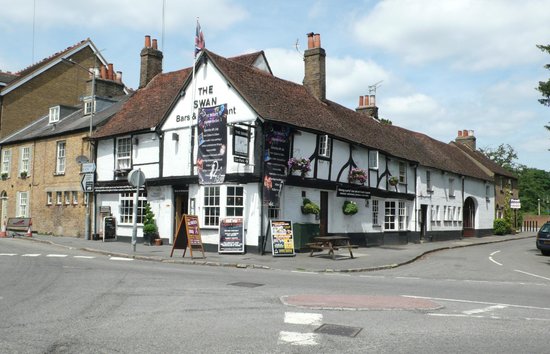
Most of my readers are familiar with the plot. Billy Bones has a sea chest in his room at the Inn he was staying at owned by Jim Hawkins' mother. After he received the "Black Spot" and is killed. Jim and his mother open it and discover a Treasure Map leading to the buried loot of legendary Captain Flint.
A ship's crew is put together to find "Treasure Island". However, the crew are mainly pirates who sailed with Flint and the one legged cook is in reality "Long John Silver'. Hiding in an apple crate Jim learns the truth and tells the ship's Captain. There is a minor mutiny before everyone reaches the island. On the island control of a stockade changes sides with Jim being captured by the Pirates. It is obvious that "Silver" likes Jim Hawkins a lot. When the treasure chest is finally dug up it is empty. Shipwrecked Ben Gunn had already found it and moved the contents to his cave. The pirates are defeated and Jim helps his "friend" Silver escape.




The motion picture was the sixth most popular release in the U.K. in 1950. Below just a small amount of the merchandise from 1950 related to the movie's release.

Probably the most famous and still most popular motion picture version of the "Robin Hood Legend" is Warner Brothers 1938 "The Adventures of Robin Hood" starring Errol Flynn, Olivia de Havilland, Basil Rathbone and Claude Rains. Like "Treasure Island" 1908 saw the first motion picture version about the outlaw of Sherwood Forest. 1951 would be Walt Disney's turn, His version was entitled "The Story of Robin Hood and His Merrie Men" aka: "The Story of Robin Hood". Which I consider the best filmed version that has been made to the date of the publication of this article.
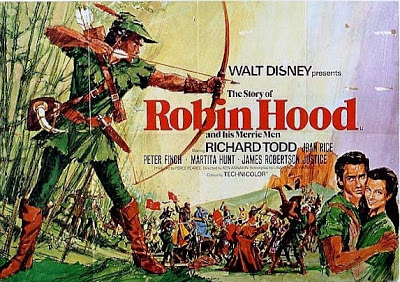
The movie was also shot at Denham Studios and in Buckinghamshire. The feature was completed in 1951, but did not have it's premiere until March 13, 1952 in London and was released in the United States on June 26, 1952.
Playing Robin Hood was Richard Todd.
For those familiar with Daryl F. Zanuck's motion picture about the World War 2 D-Day Invasion of Europe by the allies "The Longest Day". Todd played Major John Howard whose gliders were dropped in Normandy to take and hold "until relieved" the "Pegasus Bridge". In real life it was Richard Todd who actually led Howard's relief column. Talk about a motion picture reflecting real life.
Before playing Robin Hood. Richard Todd had appeared in seven British motion pictures after the War had ended, Prior to war he had only been a non-screen credited extra. One of the seven pictures was set in Burma during the Second World War entitled "The Hasty Heart", Although a British production the movie starred American's Patrica Neal and Ronald Reagan. Richard Todd had third billing. The role of Robin Hood in the Disney picture was at a turning point in Todd's career as he moved from being an extra before the war to fourth, or third billing and now clearly the star.
Robin's love Maid Marian was portrayed by Joan Rice. Rice would be basically known for this picture, playing opposite Burt Lancaster in 1954's "His Majesty O'Keefe" and the grave robber's wife in Hammer Studio's parody of it's own 1957 "The Curse of Frankenstein" 1970's "The Horror of Frankenstein", A fun film, if you know the original and are in on the joke.
Portraying the Sheriff of Nottingham was Peter Finch. Although born in England Finch was Australian. His acting career, like Richard Todd's, was interrupted by the Second World War were he served with Australian troops in the Middle East. However, unlike Todd. Finch was able to work in acting as he toured army bases and performed there when not needed in the line.

James Robertson Justice was "Little John" and before his distinguished acting career Justice was a policeman for "The League of Nation's" in a section of Germany under French and German rule. As the Nazi's rose to power the future actor left Germany and the role of policeman. He next fought on the Republican side of the Spanish Civil War July 17, 1936 to April 1, 1939. With the outbreak of World War 2 James Robertson Justice joined a Naval Reserve Unit and in 1943 was pensioned out due to a shrapnel injury. In 1944 he started motion picture acting as an extra.
Playing Friar Tuck was James Hayter who would reprise the roll in Hammer Studio's 1967 "A Challenge for Robin Hood".
The screenplay for "The Story of Robin Hood and His Merrie Men" was by Lawrence Edward Watkin. Watkin had scripted "Treasure Island" and would write the screenplays for eight other Walt Disney motion pictures. The 1950 nature series film "Beaver Valley", 1956's "The Great Locomotive Chase", 1958's "The Light in the Forest", 1959's"Darby O'Gill and the Little People", 1960's "Ten Who Dared" and 1972's "The Biscuit Eater". Along with the next two motion pictures I will be mentioning in this article.
The story finds young Robin in love with Maid Marian. He is tricked into entering an archery contest against the Sheriff of Nottingham which he wins. On his way home with his father the two are ambushed by Prince John's men and Robin's father is murdered. Robin is forced to give up his property and becomes an outlaw in Sherwood Forest defending the poor and finding a way to rescue the rightful King Richard from a prison in Austria.
Yes, the story is very familiar, but this film has the Disney touch and an outstanding British cast.
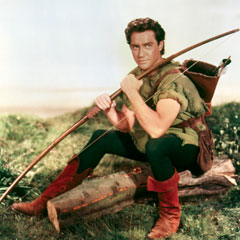

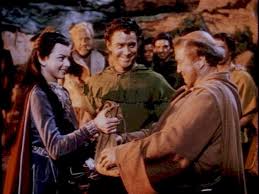
Some of the merchandise that came out with the motion picture's release.
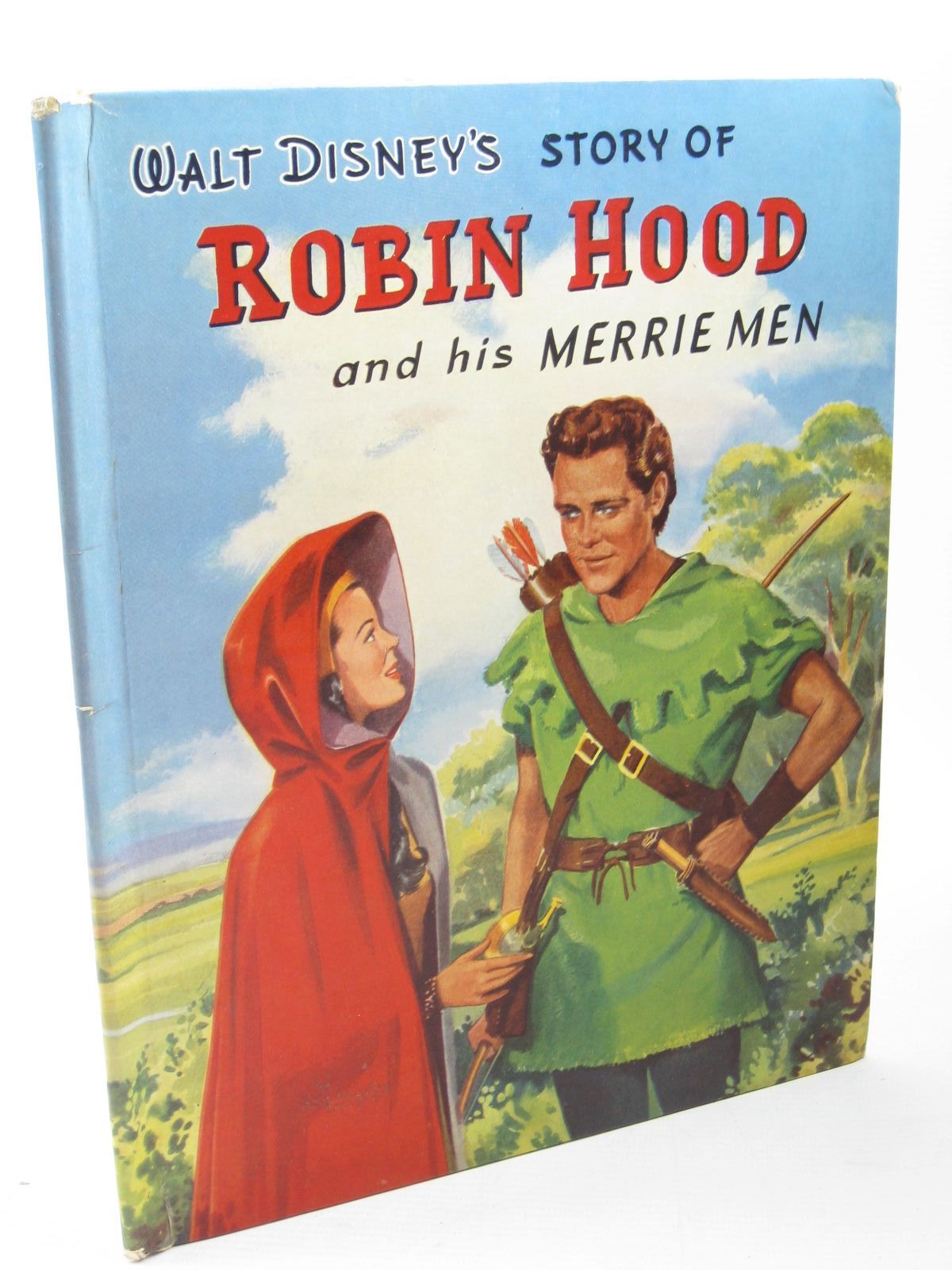

There was also a picture strip made for "The Story of Robin Hood and his Merrie Men". The two plates below are from it, The story behind the strip can be read at:
http://disneysrobin.blogspot.com/2011/02/picture-strip-21-walt-disneys-story-of.html


Richard Todd would be back in 1953's "The Sword and the Rose" aka: "When Knighthood Was In Flower". I could not locate the date the film opened in the U.K. and depending upon the source the picture either opened in the United States July 23, 1953, or August 8, 1953. I believe the first date might have been the United States premiere.

The feature film was based upon a 1898 novel by Charles Major "When Knighthood Was in Flower" and would have that title when the 92 minute motion picture was broadcast in two parts on Walt Disney's "The Wonderful World of Disney" television series.
The historical plot revolves around Mary Tutor as portrayed by Glynis Johns.

Prior to the Disney picture Johns had appeared in 28 feature films including an non-screen credit part in Alexander Korda's 1940 classic "The Thief of Bagdad". American's had recently seen her in 1951's "No Highway in the Sky" were she co-starred with James Stewart, if my readers have never seen this picture find it. The idea is that after a certain amount of flight time the tail section of a particular and popular passenger plane would just fall off from stress. The story finds Johns, Stewart and Marlene Dietrich on a plane that has reached that point of flight time. Disney fans know Glynis Johns also as Mrs. Banks in "Mary Poppins".
Richard Todd was cast as Mary's true love Charles Brandon.

James Robertson Justice was Henry the 8th
The story finds young Robin in love with Maid Marian. He is tricked into entering an archery contest against the Sheriff of Nottingham which he wins. On his way home with his father the two are ambushed by Prince John's men and Robin's father is murdered. Robin is forced to give up his property and becomes an outlaw in Sherwood Forest defending the poor and finding a way to rescue the rightful King Richard from a prison in Austria.
Yes, the story is very familiar, but this film has the Disney touch and an outstanding British cast.

Some of the merchandise that came out with the motion picture's release.


There was also a picture strip made for "The Story of Robin Hood and his Merrie Men". The two plates below are from it, The story behind the strip can be read at:
http://disneysrobin.blogspot.com/2011/02/picture-strip-21-walt-disneys-story-of.html


Richard Todd would be back in 1953's "The Sword and the Rose" aka: "When Knighthood Was In Flower". I could not locate the date the film opened in the U.K. and depending upon the source the picture either opened in the United States July 23, 1953, or August 8, 1953. I believe the first date might have been the United States premiere.

The feature film was based upon a 1898 novel by Charles Major "When Knighthood Was in Flower" and would have that title when the 92 minute motion picture was broadcast in two parts on Walt Disney's "The Wonderful World of Disney" television series.
The historical plot revolves around Mary Tutor as portrayed by Glynis Johns.
Prior to the Disney picture Johns had appeared in 28 feature films including an non-screen credit part in Alexander Korda's 1940 classic "The Thief of Bagdad". American's had recently seen her in 1951's "No Highway in the Sky" were she co-starred with James Stewart, if my readers have never seen this picture find it. The idea is that after a certain amount of flight time the tail section of a particular and popular passenger plane would just fall off from stress. The story finds Johns, Stewart and Marlene Dietrich on a plane that has reached that point of flight time. Disney fans know Glynis Johns also as Mrs. Banks in "Mary Poppins".
Richard Todd was cast as Mary's true love Charles Brandon.

James Robertson Justice was Henry the 8th
Playing the Duke of Buckingham was Michael Gough. Gough is known to many readers for the role of Alfred in Tim Burton's "Batman" and the two sequels that followed. I remember Michael Gough for his British horror films starting with playing Arthur in Hammer Film's "Dracula" aka: "The Horror of Dracula", "Horrors in the Black Museum", "Konga", Hammer's "The Phantom of the Opera", "Dr. Terror's House of Horrors", "The Skull" and "The Legend of Hell House". Among other roles including Shakespeare on stage and screen.
The motion picture is an excellent period piece and tells of Mary Tutor's love for a commoner Charles Brandon. The Duke of Buckingham also is in love with Mary and looks down upon Brandon's social status. Charles Brandon decides to leave England for the New World. His motivation is the conflict of his love for a royal princess and the fact he is a commoner. Against the advise of her Lady in Waiting, Lady Margaret, played by Jane Barrett, Mary goes to the port of Bristol dressed as a boy. Charles and Mary plan to leave together on a ship, but Henry's men show up, Brandon is incarcerated in the Tower of London.



Henry the 8th wants to marry Mary Tutor to the elderly King Louis of France. She agrees to the marriage only if Brandon is freed. Henry agrees to her request with has the caveat that the King will permit Mary to choose her second husband . The now Queen of France starts to get Louis to drink heavily and become very active in her plan to worsen his deteriorating health. Unknown to Mary King Louis' heir Francis, Gerard Oury, plans to keep her in France once he becomes King.
As they use to say "The Plot Thickens" as Lady Margaret is informed by the Duke of Buckingham that Charles Brandon is dead, but has no way of informing Mary in France. After King Louis dies Buckingham arrives in France to bring Mary Tutor back and force her into a marriage with himself. Part of his plan is to tell her the same story he told Lady Margaret that Charles is dead. However, the still alive Brandon appears and kills the Duke. Mary and Charles return to England. Where she reminds King Henry the 8th of his promise to let her choose a second husband. Charles Brandon becomes the 1st Duke of Suffolk.



The motion picture did not fair well in the U.K. and didn't last long on screens in the United States either. The objections in England were over the broad characterizations of the historical figures involved and other inaccuracies in the screenplay. In the U.S. the film bored children the normal target audience for a Walt Disney production. The same problems were about to face the last of these four Walt Disney productions.
1953's, "Rob Roy, the Highland Rogue" had the same cast as "The Sword and the Rose" and told the story of the Scottish Clan leader who fought against King George the First for Scotland's freedom.

Richard Todd was Rob Roy MacGregor.

Glynis Johns played his wife Helen Mary MacPherson MacGregor.

James Robertson Justice portrayed John Campbell, the Duke of Argyll,
The motion picture is an excellent period piece and tells of Mary Tutor's love for a commoner Charles Brandon. The Duke of Buckingham also is in love with Mary and looks down upon Brandon's social status. Charles Brandon decides to leave England for the New World. His motivation is the conflict of his love for a royal princess and the fact he is a commoner. Against the advise of her Lady in Waiting, Lady Margaret, played by Jane Barrett, Mary goes to the port of Bristol dressed as a boy. Charles and Mary plan to leave together on a ship, but Henry's men show up, Brandon is incarcerated in the Tower of London.
Henry the 8th wants to marry Mary Tutor to the elderly King Louis of France. She agrees to the marriage only if Brandon is freed. Henry agrees to her request with has the caveat that the King will permit Mary to choose her second husband . The now Queen of France starts to get Louis to drink heavily and become very active in her plan to worsen his deteriorating health. Unknown to Mary King Louis' heir Francis, Gerard Oury, plans to keep her in France once he becomes King.
As they use to say "The Plot Thickens" as Lady Margaret is informed by the Duke of Buckingham that Charles Brandon is dead, but has no way of informing Mary in France. After King Louis dies Buckingham arrives in France to bring Mary Tutor back and force her into a marriage with himself. Part of his plan is to tell her the same story he told Lady Margaret that Charles is dead. However, the still alive Brandon appears and kills the Duke. Mary and Charles return to England. Where she reminds King Henry the 8th of his promise to let her choose a second husband. Charles Brandon becomes the 1st Duke of Suffolk.
The motion picture did not fair well in the U.K. and didn't last long on screens in the United States either. The objections in England were over the broad characterizations of the historical figures involved and other inaccuracies in the screenplay. In the U.S. the film bored children the normal target audience for a Walt Disney production. The same problems were about to face the last of these four Walt Disney productions.
1953's, "Rob Roy, the Highland Rogue" had the same cast as "The Sword and the Rose" and told the story of the Scottish Clan leader who fought against King George the First for Scotland's freedom.

Richard Todd was Rob Roy MacGregor.
Glynis Johns played his wife Helen Mary MacPherson MacGregor.
James Robertson Justice portrayed John Campbell, the Duke of Argyll,
Michael Gough was the Duke of Montrose.

The motion picture was filmed in Scotland and opens with a major battle sequence as Rob Roy and the Clan MacGregor attack the forces of George the First under the Duke of Argyll. Argyll wants to stop the rebellion against the King, but has sympathy for the Scot fighters. He holds back the German Mercenaries under his command and the battle ends with both sides retaining "honor". Rob Roy and his men disperse.
Rob Roy returns to his home to marry the women he loves. The ceremony is broken up by the private army of the new Secretary of State the Duke of Montrose. Rob Roy is arrested and the Clam MacGregor is not permitted to be recognized by that name.


However, Rob Roy escapes and organizes opposition to the cruel rule of Montrose. The Clan MacGregor seizes a fort and holds English soldiers as hostages against the Duke. The Duke of Argyll intervenes by going directly to King George the First. Rob Roy is pardoned and returns to his home and wife. The Clan MacGregor's name is restored.




As with the other three motion pictures there was a Dell Comic Book accompanying "Rob Roy, the Highland Rogue". Comic book versions of major motion pictures were a common practice during the 1950's.

The movie was the last picture released by Walt Disney through RKO Studios. His next feature film and Cartoon would be under Walt Disney's own "Buena Vista" company.
With the low box office in the United States Walt Disney decided to end making "Costume" Motion Pictures. The low returns on "The Sword and the Rose" and "Rob Roy, the Highland Rogue" were not caused by the quality of the pictures, but the unfamiliarity with the real life people involved outside of the United Kingdom with mostly the target audience children. I was only seven when I saw Rob Roy, but I remember enjoying the picture and of course had no idea he was a real person.
All four motion pictures are available on DVD and are worth a look by my readers.
The following link takes my reader to another of my blog articles. This is an in-depth look at Walter Elias Disney and his feud with Max Fleischer the creator of "Betty Boop", "Popeye the Sailor" and the first "Superman" cartoons. It's the story of one man's rise and another's fall. Along with the charges that Walt Disney was a racist. Even before the motion picture "The Song of the South" I mentioned above starring Bobby Driscoll.
http://kinescopedreams.blogspot.com/2015/04/the-great-walt-disney-max-fleischer.html
The motion picture was filmed in Scotland and opens with a major battle sequence as Rob Roy and the Clan MacGregor attack the forces of George the First under the Duke of Argyll. Argyll wants to stop the rebellion against the King, but has sympathy for the Scot fighters. He holds back the German Mercenaries under his command and the battle ends with both sides retaining "honor". Rob Roy and his men disperse.
Rob Roy returns to his home to marry the women he loves. The ceremony is broken up by the private army of the new Secretary of State the Duke of Montrose. Rob Roy is arrested and the Clam MacGregor is not permitted to be recognized by that name.
However, Rob Roy escapes and organizes opposition to the cruel rule of Montrose. The Clan MacGregor seizes a fort and holds English soldiers as hostages against the Duke. The Duke of Argyll intervenes by going directly to King George the First. Rob Roy is pardoned and returns to his home and wife. The Clan MacGregor's name is restored.
As with the other three motion pictures there was a Dell Comic Book accompanying "Rob Roy, the Highland Rogue". Comic book versions of major motion pictures were a common practice during the 1950's.
The movie was the last picture released by Walt Disney through RKO Studios. His next feature film and Cartoon would be under Walt Disney's own "Buena Vista" company.
With the low box office in the United States Walt Disney decided to end making "Costume" Motion Pictures. The low returns on "The Sword and the Rose" and "Rob Roy, the Highland Rogue" were not caused by the quality of the pictures, but the unfamiliarity with the real life people involved outside of the United Kingdom with mostly the target audience children. I was only seven when I saw Rob Roy, but I remember enjoying the picture and of course had no idea he was a real person.
All four motion pictures are available on DVD and are worth a look by my readers.
The following link takes my reader to another of my blog articles. This is an in-depth look at Walter Elias Disney and his feud with Max Fleischer the creator of "Betty Boop", "Popeye the Sailor" and the first "Superman" cartoons. It's the story of one man's rise and another's fall. Along with the charges that Walt Disney was a racist. Even before the motion picture "The Song of the South" I mentioned above starring Bobby Driscoll.
http://kinescopedreams.blogspot.com/2015/04/the-great-walt-disney-max-fleischer.html





No comments:
Post a Comment